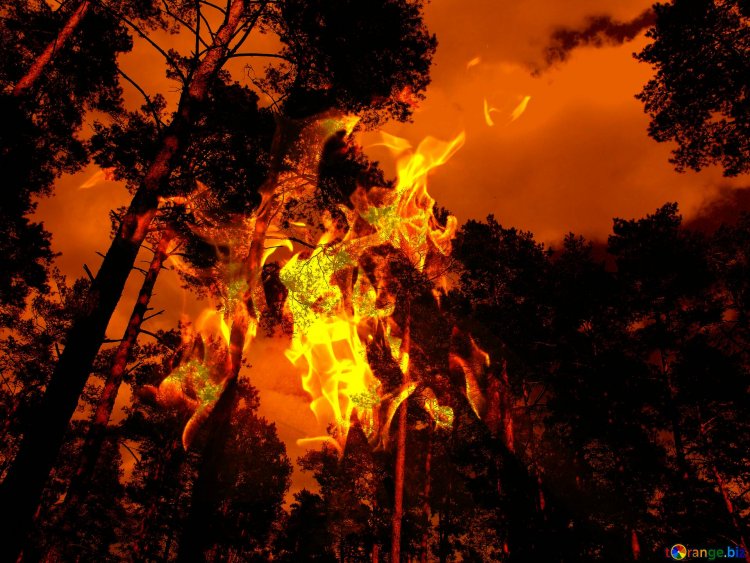The Increasing Forest Fire in Nepal
Explore the escalating threat of forest fires in Nepal, their causes, consequences, and the urgent need for effective prevention and management strategies

The incidence of forest fires in Nepal has been progressively increasing each year, reaching a point where it is no longer considered normal. Over the past 18 years since 2005, Nepal has experienced an average annual loss of 200,000 hectares of the jungle due to these fires, an area more than twice the size of Chitwan National Park. The destructive impact extends beyond the loss of trees, as these forest fires have claimed the lives of over 166 individuals in the last two decades. Additionally, Kathmandu, both two years ago and presently, has gained notoriety as one of the most polluted cities, largely due to the surrounding forest fires. It is concerning that out of the 77 districts, 73 have witnessed forest fires in recent years, signifying the widespread burning of Nepal's forests. Unfortunately, the relevant authorities do not appear to be adequately addressing this issue or expressing sufficient concern. Generally, we tend to believe that a dense forest indicates a healthy environment. However, numerous studies have shown that as forests become denser, the competition among trees intensifies which can negatively impact their growth and increase the risk of forest fires. Instead of focusing solely on creating dense and thick forests, people need to prioritize maintaining a delicate balance within the forest ecosystem.
Forest fires are a natural occurrence that can benefit the forest by providing essential nutrients to the land. However, the real issue arises when the fire's temperature escalates excessively, causing it to spiral out of control and spread to other areas. In Nepal, the forest fire season commences in November, reaches its peak between March and April, and concludes in June. While natural and controlled fires are not problematic, the forest fires seen today are often not natural in origin. It is estimated that nearly 90% of these fires are human-made, ranging from the carelessness of young children to individuals who carelessly discard burning cigarettes or even fires ignited by people attempting to capture animals. However, the primary causes of these fires are usually related to agriculture and activities involving animals.
Below are Several Factors that Contribute to the Occurrence of Forest Fires:
-
To expand the available grazing areas for animals and ensure an adequate food supply, a practice has emerged whereby lands are intentionally subjected to controlled fires. However, it is unfortunate that on certain occasions, these fires can extend beyond their intended boundaries and encroach upon the neighboring jungle or forested areas.
-
In Nepal, slash-and-burn or swidden farming is commonly practiced. Farmers clear land by cutting and burning vegetation. This tradition sustains communities but risks wildfires. Nepalese rural communities often use slash-and-burn agriculture to clear land for crops. Risky practice. Slash-and-burn fires can easily spread, causing wildfires. Dry weather, winds, and proximity to flammable materials worsen fire hazards for farmers. Unattended wildfires can threaten nearby ecosystems, wildlife, and settlements.
-
Humans often ignite forest fires through careless behavior, such as tossing lit cigarettes, leaving campfires unattended, or burning garbage near forests. Lit cigarettes and matches carelessly discarded cause forest fires due to underestimation of their potential consequences. A cigarette butt or match can easily ignite dry vegetation, causing wildfires that rapidly spread and damage forests. Unattended campfires also cause forest fires. Failure to extinguish or contain fires endangers nearby forests. Embers can reignite, causing uncontrolled fires. Unattended campfires near flammable materials increase forest fire risk. Burning garbage near forests is dangerous. Burning waste irresponsibly can cause forest fires. Burning debris can spark and ignite nearby vegetation. Reckless behavior endangers the vicinity and forest ecosystem, risking flora and fauna.
-
Illegal logging and collection of forest products fuel forest fires. Sometimes, fire is used to clear vegetation or access resources. If unchecked, fires can escalate into destructive forest fires. Illegal logging often uses fire to quickly clear forests. Flames are used to clear vegetation for logging. Lack of fire management leads to rapid spread and threatens the ecosystem. The gathering of forest products can often involve fire. People may intentionally start fires to clear space or access resources. Improper precautions and fire control can cause forest fires to worsen, especially in bad weather.
-
Climate impacts forest fires. Specific weather can promote fires. Drought, low humidity, high temps, and strong winds increase forest fire risk and severity. Drought causes dry vegetation that fuels fires. Without enough moisture, the forest is less lush and vulnerable to fire. Dry vegetation is highly flammable and can easily ignite. Low humidity can increase forest fire risk in drought or arid areas. Dry air absorbs moisture from vegetation quickly. A dry environment is more flammable and easily ignitable. High temperatures increase the risk of forest fires, especially in hot summers or in Mediterranean regions. As temperatures rise, vegetation dries out more and ignites easily. High temperatures increase plant moisture evaporation, worsening flammability. A spark can quickly ignite a forest fire under these conditions. Strong winds spread forest fires. The wind carries burning debris, aiding fires to spread quickly. Gusts worsen wildfires, making them harder to control. The climate factors increase forest fire risk. With aligned factors, fires pose a significant threat to nature and communities.
Consequences:
- Undoubtedly, forest fires have profound and detrimental effects on both the trees and the endangered animal species that rely on these ecosystems. The impacts of such fires extend beyond the immediate destruction of vegetation, posing a serious threat to the delicate balance of wildlife populations and their habitats. A distressing example of this occurred in the year 2012 when a devastating fire engulfed Bardiya National Park, resulting in the tragic loss of 40% of small mammals, 60% of insects, and a significant number of birds.
- In areas where air pollution levels are already alarmingly high, the occurrence of forest fires poses an even greater threat to respiratory health and overall well-being. Forest fires emit a plethora of pollutants into the atmosphere, including particulate matter, harmful gases, and toxic chemicals. When these pollutants mix with the already polluted air, the consequences become more severe, exacerbating the difficulties associated with breathing and leading to a range of additional health impacts.
- Forest fires harm soil quality causing degradation and erosion. Fires impact soil fertility and stability long-term via intense heat. The effect of forest fires on soil is altering its physical properties. Fires alter soil. Heat harms soil fertility by destroying organic matter and vital nutrients. Heat can compact soil and reduce water absorption. Soil's ability to support plants is reduced due to nutrient loss. The fire destroys vegetation and removes natural protection against soil erosion. Sheet erosion causes topsoil loss, which hinders plant growth. Loss of topsoil impacts soil fertility. Topsoil is the most vital layer of soil with high organic matter, nutrients, and microorganisms.
- Forest fires release greenhouse gases, contributing to climate change. Fires release stored carbon as CO2 into the atmosphere by burning organic matter. Increased CO2 worsens global warming by enhancing greenhouse gases. Forest fires' greenhouse gas emissions have far-reaching consequences. CO2 and other greenhouse gases disperse globally, affecting Earth's climate system. Greenhouse gases trap heat and cause global warming. Climate change consequences go beyond forest fire impacts. Global warming melts ice, raising sea levels. Sea level rise threatens coastal regions with millions of inhabitants. Altered weather patterns can increase flooding and damage to infrastructure and communities.
History and Current Situation:
During the period from the 1950s to the 1980s, Nepal experienced significant deforestation, with a major portion of the forests being cleared for timber and the remaining jungles converted into agricultural land. In response to this issue, a crucial decision was made to transfer forest ownership to the local communities. This initiative was accompanied by the implementation of the Forest Act of 2049, which included an extensive reforestation program. The Forest Act of 2049 was recognized as one of the most stringent forest-related legislation worldwide. As a result of these efforts, Nepal's forest cover was able to double by 2016 AD. However, the current situation is transforming as the community forest model faces a crisis. The Department of Forest Fire lacks a dedicated team equipped to handle forest fires and also suffers from a lack of appropriate equipment.
It is evident that as climate change continues to progress, the risk and challenges posed by forest fires will intensify. To mitigate this problem, the relevant department must receive increased attention. This includes establishing a dedicated response team and raising awareness among the public about the importance of forest fire prevention and management.
What's Your Reaction?





































































































